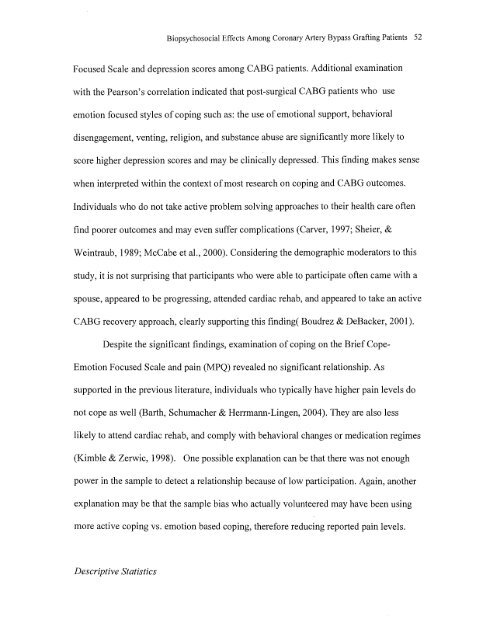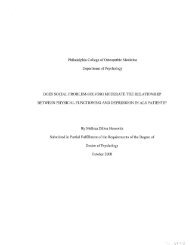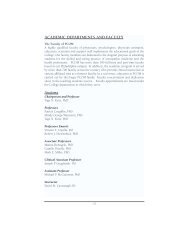0 - Philadelphia College of Osteopathic Medicine
0 - Philadelphia College of Osteopathic Medicine
0 - Philadelphia College of Osteopathic Medicine
You also want an ePaper? Increase the reach of your titles
YUMPU automatically turns print PDFs into web optimized ePapers that Google loves.
Biopsychosocial Effects Among Coronary Artery Bypass Grafting Patients 52<br />
Focused Scale and depression scores among CABG patients. Additional examination<br />
with the Pearson's correlation indicated that post-surgical CABG patients who use<br />
emotion focused styles <strong>of</strong> coping such as: the use <strong>of</strong> emotional support, behavioral<br />
disengagement, venting, religion, and substance abuse are significantly more likely to<br />
score higher depression scores and may be clinically depressed. This finding makes sense<br />
when interpreted within the context <strong>of</strong> most research on coping and CABG outcomes.<br />
Individuals who do not take active problem solving approaches to their health care <strong>of</strong>ten<br />
find poorer outcomes and may even suffer complications (Carver, 1997; Sheier, &<br />
Weintraub, 1989; McCabe et aI., 2000). Considering the demographic moderators to this<br />
study, it is not surprising that participants who were able to participate <strong>of</strong>ten came with a<br />
spouse, appeared to be progressing, attended cardiac rehab, and appeared to take an active<br />
CABG recovery approach, clearly supporting this finding( Boudrez & DeBacker, 2001).<br />
Despite the significant findings, examination <strong>of</strong> coping on the Brief Cope<br />
Emotion Focused Scale and pain (MPQ) revealed no significant relationship. As<br />
supported in the previous literature, individuals who typically have higher pain levels do<br />
not cope as well (Barth, Schumacher & Herrmann-Lingen, 2004). They are also less<br />
likely to attend cardiac rehab, and comply with behavioral changes or medication regimes<br />
(Kimble & Zerwic, 1998). One possible explanation can be that there was not enough<br />
power in the sample to detect a relationship because <strong>of</strong> low participation. Again, another<br />
explanation may be that the sample bias who actually volunteered may have been using<br />
more active coping vs. emotion based coping, therefore reducing reported pain levels.<br />
Descriptive Statistics






